Source: Timing and Entries 



When partner puts down dummy, the first things you should do (after thanking him, even if his hand really sucks) are: [Belladonna/Garozzo used to have the convention «thank you» for a good dummy, «grazie» for a bad dummy – Ed]
- Count your winners. Winners does not just refer to top tricks, it can also refer to tricks you can definitely set up—e.g. KQJx has two winners and perhaps a third.
- Count your losers. These are the tricks you might lose if things go badly—e.g. if you hold AQ in a suit, you might lose the king.
There are four cases to consider:
- You have enough winners to make your contract and not enough losers to go down. Assuming you’ve counted correctly, you should be able to make your contract. Well bid!
- You have enough winners to make your contract, but also enough losers to defeat it. This is the most common situation. You have to time things carefully to make your tricks before your opponents make theirs.
- You don’t have enough winners to make your contract or enough losers to defeat it quickly. In this case you need to find ways to get more tricks. Some ways you might try will be covered in a later article.
- You don’t have enough winners to make your contract, but the opponents have enough quick winners to take it off. Oh dear! Don’t worry, you can’t win them all. Hopefully you weren’t doubled.
Let’s look at some examples (West is declarer):
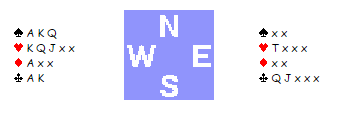
Contract: 6
Lead:  K
K
Hopefully this should be an easy one to start with. You have 3 spade winners, 4 heart winners, 1 diamond winner, and 4 club winners. That makes 12—enough to make your contract. On the other hand, you have the  A and the
A and the  Q to lose—that’s enough to defeat your contract. You need to get rid of one of your losers. You can’t avoid losing the
Q to lose—that’s enough to defeat your contract. You need to get rid of one of your losers. You can’t avoid losing the  A, but if you can discard dummy’s second diamond before defense get in, you’ll be able to ruff a
A, but if you can discard dummy’s second diamond before defense get in, you’ll be able to ruff a  in dummy instead of losing it. Therefore, you should cash three spades discarding a diamond before drawing trumps (draw trumps by playing the honours from hand first, so that you can ruff diamonds high in dummy and avoid risking an overruff).
in dummy instead of losing it. Therefore, you should cash three spades discarding a diamond before drawing trumps (draw trumps by playing the honours from hand first, so that you can ruff diamonds high in dummy and avoid risking an overruff).
 Contract: 3NT
Contract: 3NT
Lead:  K
K
Now try playing this in 3NT on a spade lead. You have 1 spade, 3 hearts, 5 diamonds and 3 clubs, which is 12 tricks—easily enough to make your contract. Alas, you also have at least 4 spades and the  A to lose. Therefore, if you try to set up any diamond tricks, you will be defeated.
A to lose. Therefore, if you try to set up any diamond tricks, you will be defeated.
Instead, you must hope to make 9 tricks in clubs, hearts and spades, without ever resorting to diamonds. This is just possible if you can make 5 club tricks. For this, you will need Kxx or Kx of clubs onside—about a 34% chance. Not great, but the best you’re going to get. Win the  A, then lead the
A, then lead the  x (this gives the additional chance of a singleton K onside) to the Q. Play a heart back to the A and run the
x (this gives the additional chance of a singleton K onside) to the Q. Play a heart back to the A and run the  J.
J.
Entries and hold-ups
 Contract: 3NT
Contract: 3NT
Lead:  Q
Q
You have 8 tricks, and with 9 diamonds between the hand, excellent chances of being able to set up some diamonds. So you win the  K and try AK of diamonds, hoping for a 2–2 break, which would give you all the tricks. Suppose they break 3–1. What now? You continue with a third diamond to set them up. An opponent wins and leads a club to your A. This is the position:
K and try AK of diamonds, hoping for a 2–2 break, which would give you all the tricks. Suppose they break 3–1. What now? You continue with a third diamond to set them up. An opponent wins and leads a club to your A. This is the position:
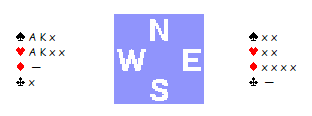
You now have plenty of tricks, but no way of taking them; in order to take your diamond tricks, the lead must be in dummy, and dummy has no cards that might win a trick. You have to hope to win the 9th trick in your hand, and basically it’s hopeless.
What went wrong? Should we have played differently?
Yes. We should have seen the possibility that we might not have the entry to dummy and tried to avoid it. We need to keep the top diamond as an entry to dummy after we have lost a diamond. To do this, we play a low diamond from dummy at trick 2. We lose this trick, but we can win the next one and (unless diamonds are 4–0) we can then win all our remaining diamonds. This is an example of a safety-play where we give up a possible overtrick in diamonds to maximise our chances of winning most of the tricks and making our contract.
Another important point about entries is that in general, when cashing long suits you often need to win the high cards in the short hand before playing all the low cards from the short hand, since if you don’t, you will have to cash the high cards from the short hand, and then find an entry to the long hand in another suit if you can. For example, consider the following hand, playing in 3NT on a heart lead:
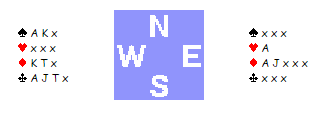 Contract: 3NT
Contract: 3NT
Lead:  x
x
Your opponents certainly have enough heart tricks to beat your contract if you let them in before you have taken 9 tricks, so you must take your 9 tricks at once, which means you need to win 6 diamond tricks. You work out that your best chance is to take a finesse, but which way? It is best to cash one honour before finessing in case the Q is singleton. Suppose you cash the A then finesse the T. Now the position will be:
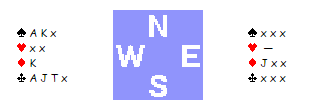 You can cash the K, dropping the Q, but you don’t have an entry to dummy to get your two top diamonds. Therefore, the better way of playing is to win the
You can cash the K, dropping the Q, but you don’t have an entry to dummy to get your two top diamonds. Therefore, the better way of playing is to win the  K then finesse the J.
K then finesse the J.
A suit where the top cards are all in a hand with no small cards is called blocked. It is usually right to avoid your suits being blocked if possible, and to get rid of the blocking cards as soon as possible. Sometimes drastic measures are required in order to do this:
 Contract: 3NT
Contract: 3NT
Lead:  x
x
Playing 3NT on a club lead, the best line (and the only one that offers a significant chance) is to win it, then cash two more clubs pitching the AK of diamonds! Now you can cash dummy’s top four diamonds, and if the suit breaks 4–1 or better, take the two long diamonds for the contract.
The hold-up
[«Your entries or your life!»—not to be confused with the squeeze, which is extracting tricks with menaces – Ed]
As well as making sure that your own entries are preserved, you need to do your best to try to disrupt the entries of the defensive hands. Consider the following hand: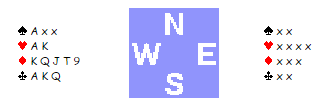 Contract: 3NT
Contract: 3NT
Lead:  K
K
You have ten tricks if you have time to set them up. Alas, there is the danger that one of your opponents might have 5 spades and when you lose a trick to the  A, he will cash them, leaving you one down. What can you do about this (apart from play in 5
A, he will cash them, leaving you one down. What can you do about this (apart from play in 5 )?
)?
If the opponent with 5 spades has the  A, there is nothing you can do to stop him. However, if it’s his partner who has the
A, there is nothing you can do to stop him. However, if it’s his partner who has the  A, there is something you can do: make sure he doesn’t have any spades left when he wins the
A, there is something you can do: make sure he doesn’t have any spades left when he wins the  A! To achieve this, simply wait to take your
A! To achieve this, simply wait to take your  A until the third round. Now if one opponent started with five spades, his partner started with only three, so won’t have any left when he wins the
A until the third round. Now if one opponent started with five spades, his partner started with only three, so won’t have any left when he wins the  A. Therefore, he will be forced to lead a different suit, which you can win and cash your tricks for +1.
A. Therefore, he will be forced to lead a different suit, which you can win and cash your tricks for +1.
Warning—whenever you consider holding up, make sure that there isn’t another suit defense might switch to that could be more harmful.
